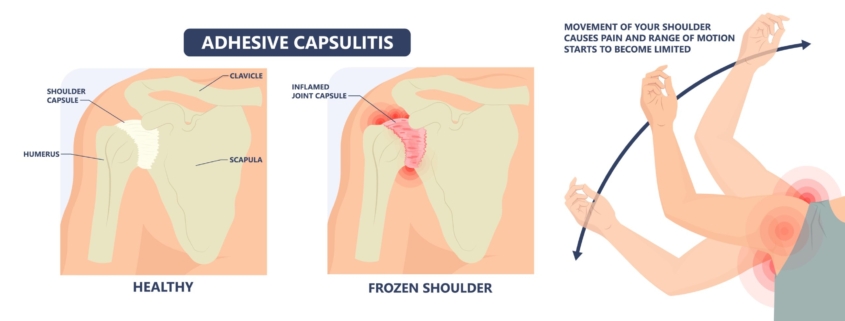Adhesive Capsulitis

Overview
Adhesive Capsulitis, also known as frozen shoulder, is a painful and disabling condition in which you experience stiffness and limited range of motion in your shoulder joint. Globally, it affects between 2% and 3% of people, with higher prevalence among women and individuals aged between 40 to 60 years. Essentially, it happens when the tissues in your shoulder joint become thicker, tighter, gradually forming scar tissue, which leads to difficulty in movement.
Types
Adhesive capsulitis can be categorized into two major types:
1. Primary or idiopathic adhesive capsulitis: This is where the cause is unknown.
2. Secondary adhesive capsulitis: Occurs as a result of an underlying condition or event such as an injury, surgery, or an illness that has kept you immobilized for a period of time.
Causes
The exact cause of adhesive capsulitis is unknown. However, several factors increase the risk including:
– Age and gender: People over 40, particularly women, are more likely to develop the condition.
– Immobility or reduced mobility: Prolonged immobility of the shoulder, such as after surgery or an arm fracture, can put you at higher risk.
– Systemic diseases: Conditions like diabetes, thyroid problems, cardiovascular diseases or Parkinson’s disease may increase your chances of developing adhesive capsulitis.
Symptoms
The most prominent signs and symptoms of adhesive capsulitis include:
– Persistent pain in your shoulder
– Difficulty in carrying out everyday tasks, like reaching for items or dressing
– Reduced mobility of your shoulder
– Pain that worsens at night
The condition typically develops gradually, getting worse over time before finally starting to improve.
Diagnosis
Your healthcare provider will diagnose adhesive capsulitis based on a physical examination and your medical history. They may ask you to perform certain movements to assess the range of motion and level of discomfort. If necessary, imaging tests like X-rays, ultrasound or MRI may be used to rule out other conditions like a rotator cuff injury.
Treatment Options
Though adhesive capsulitis can resolve on its own, treatment helps to relieve pain and restore movement. The options include:
– Physical Therapy: Exercises to maintain as much mobility and flexibility as possible.
– Medications: Over-the-counter and prescription pain-relievers and anti-inflammatories.
– Steroid injections: To reduce inflammation and pain.
– Surgery: In severe cases, a minimally invasive procedure to break up the scar tissue.
Living With Adhesive Capsulitis
Living with adhesive capsulitis can be challenging. Here are some practical tips:
– Practice your prescribed physical exercises consistently.
- Use pain relief medications as directed by your healthcare provider.
– Invest in heat or cold packs to help reduce inflammation.
– Maintain a healthy diet and lifestyle to support your immune system and general wellbeing.
When to Seek Help
While discomfort and limited motion from adhesive capsulitis can be typical, you should seek immediate medical attention if you experience unbearable pain, inability to move your shoulder at all or if your symptoms do not improve after several weeks of non-surgical treatment.
Remember, early diagnosis and treatment can make a big difference in the speed and effectiveness of your recovery.
